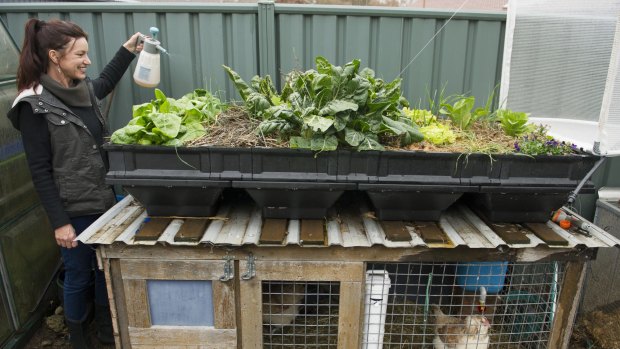This was published 7 years ago
Make your own bokashi compost with Simone Dilkara in Canberra
By Susan Parsons
"I'm paid to drive a tractor," said Simone Dilkara, as though this was the ultimate play-at-work job. However, her tractor is used at Landtasia Organic Farms, founded in 2001 on a 10,500-acre property near Bungendore, which includes a wetland park sanctuary. Under the proprietorship of Richard Graham, the team raises Angus stud beef cattle and sheep, and an apple orchard and vineyard have been established as well as organic honeybee colonies and potato cultivation. Food and garden waste from surrounding councils and from Canberra is turned into an organically certified compost.
Simone Dilkara was leading a seminar for Canberra Organic Growers Society on a recent Sunday afternoon at the Northside Community Centre in Dickson. The topics were brewing your own lactobacillus serum for adding to compost heaps or as a soil drench, foliar fertiliser or to pour into your drains as a cleanser and the creative process of making your own bokashi for the garden.

Simone Dilkara's winter vegie patch.Credit: Jay Cronan
We first met Simone six years ago in her Holder garden (Kitchen Garden, May 19, 2010) where, with her partner Paul Smith, she was keeping bees, making honey and plum wine, harvesting kiwi fruit and sowing garlic in her plot at the Holder community garden.
This winter, raised beds in their home garden are filled with English spinach, cos lettuce, silver beet and various kale varieties. There are seedlings of French carentan leeks and purple shallots, cima di rapa seedlings which are a winter green from the turnip family, and seedlings of Ailsa Craig onions, huge pale yellow onions which were named in 1887 for a domed rock/island off the coast in South Ayrshire in Scotland. In the salad bed there is mizuna, miner's lettuce, lamb's lettuce, parsley and baby spinach.
Simone Dilkara is now in charge of massive big windrows at Landtasia where they ferment the compost in a fairly wet state which she finds "very primordial and fecund" and they brew their own microbial inoculants which are the heart of the process.
At the seminar we were given recipes for the serum which is made with white rice, rain water, full-fat milk and molasses. It involves a curds and whey element from which the whey, a creamy-greyish liquid, is retained. The woman sitting next to me said the curds is wondrous stuff which she adds to the chicken feed on her farm. She also uses the serum to ferment pig feed. Everyone was taking extra notes and laughing when Simone made self-deprecating remarks or analogies like the molasses rich serum being akin to Elvis on his waterbed surrounded by chocolate eclairs but being on a food coma.
Bottles of magic potions were handed around for us to smell. Some were sour and winey, others like Christmas pud, some like acrid vinegar. At home, Simone uses the lacto serum as a starter to ferment the food for Khaki Campbell ducks, Salmon Faverolles chooks and Light Sussex hens and as a spray in the chook and duck houses. The dog gets it in his water as well.
In Dickson we learnt about making bokashi bran for composting food scraps at home. You mix rice bran with fish meal or chook poo and seeds remaining from oil extraction like canola, soy or copra. Of the latter, Simone said it is coconut meal that smells beautiful. These ingredients can be bought from Powells Stockfeeds or Bellchambers.
To the dry ingredients you add rain water, molasses and two tablespoons of diluted 1:20 lactobacillus serum. The serum is stored at room temperature. The bokashi ferments in a sealed bucket and it looks like biscuit base. A lidless bucket was handed around and the contents had a powerful stink. Once fermented, the bokashi bran can be sprinkled over food scraps when they are added to the kitchen compost bucket. Of her composting operation, Simone said that, like the model Linda Evangelista, "I don't get out of bed for less than … 30 cubic metres of greenwaste". We learnt about "cooking egg shells" and adding them to vinegar to make water-soluble calcium, using newspaper waste, adding straw to compost heaps (preferably heavy duty Gedye green bins with no air holes) in a layer after every layer of green kitchen waste.
This was the first COGS meeting I had attended. There was a great mix of members. Before the seminar people were looking through labelled boxes of organic gardening books which anyone can borrow via the 2016 librarian Michele England. After the event, afternoon tea was served and, for this meeting, it had been made by Michele. There were olive and ricotta savoury muffins and a lime and coconut cake plus a big pot of green tea. It was a friendly way to mingle with members.
There was also a produce table. COGS members are not allowed to sell produce so everything on the table is available free to members. On this occasion it was all donated by organic gardener John Brummell and included big bags of broad beans to sow, raspberry canes to plant, divided strawberry plants with good root systems in soil and big trombone-shaped gramma pumpkins (Cucurbita moschata) to cook, great in soup, scones or pies.
For more information, recipes and inspiration see: landtasiacompost.com and theunconventionalfarmer.com
Susan Parsons is a Canberra writer